Related Research Articles

Nottingham and District Tramways Company Limited was a tramway operator from 1875 to 1897 based in Nottingham in the United Kingdom.

Sheffield Tramway was an extensive tramway network serving the English city of Sheffield and its suburbs.

The Kingston upon Hull tramway network was a network of 4 ft 8+1⁄2 instandard gauge tram lines following the five main roads radially out of the city centre of Kingston upon Hull, East Riding of Yorkshire, England. Two of these lines went west, and two east. The fifth went to the north, and branched to include extra lines serving suburban areas. Additionally a short line linked the city centre to the Corporation Pier where a ferry crossed the Humber Estuary to New Holland, Lincolnshire.
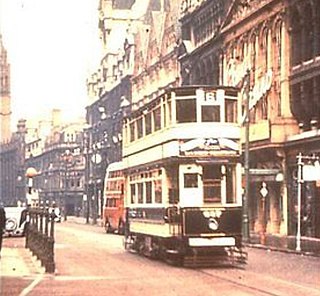
Birmingham Corporation Tramways operated a network of tramways in Birmingham from 1904 until 1953. It was the largest narrow-gauge tramway network in the UK, and was built to a gauge of 3 ft 6 in. It was the fourth largest tramway network in the UK behind London, Glasgow and Manchester.
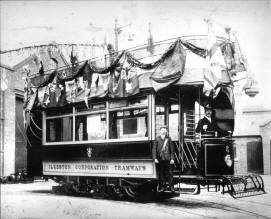
Ilkeston Corporation Tramways was a tramway network in Ilkeston, Derbyshire, in the East Midlands of England run firstly by Ilkeston Borough Council and from 1916 by the Nottinghamshire and Derbyshire Tramways Company. The system ran between 1903 and 1931. Ilkeston was the first town in Derbyshire to adopt and operate a fully electrical tramway system.

Reading Tramways Company operated a horse-drawn tramway service in Reading in the English county of Berkshire between 1879 and 1901.

Southampton Corporation Tramways were in operation from 1879 to 1949. They were initially horse-drawn, but latterly powered by electricity.

Leicester Corporation Tramways was a tramway system in Leicester, England from 1901 to 1949.

The Derby Tramways Company operated horse-drawn tramway services in Derby, England from 1880 to 1904.

Lincoln Corporation Tramways operated an electric tramway service in Lincoln, England between 1905 and 1929.

Wallasey Corporation Tramways operated an electric tramway service in Wallasey between 1902 and 1933.

Gloucester Corporation Tramways operated an electric tramway service in Gloucester between 1904 and 1933.
The Worcester Electric Traction Company operated a tramway service in Worcester between 1904 and 1928.

Tramways in Exeter were operated between 1882 and 1931. The first horse-drawn trams were operated by the Exeter Tramway Company but in 1904 the Exeter Corporation took over. They closed the old network and replaced it with a new one powered by electricity.

Dundee and District Tramways operated a tramway service in Dundee between 1877 and 1899.
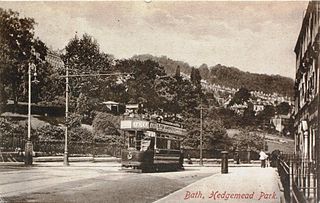
Bath Tramways Company and its successors operated a 4 ft horse-drawn tramway service in Bath between 1880 and 1902. From 1903 until its closure in 1939 an expanded route carried electric trams operated by Bath Electric Tramways Company.
Chester Tramways Company operated a horse-drawn tramway service in Chester between 1878 and 1901.
Wolverhampton Tramways Company operated a tramway service in Wolverhampton between 1878 and 1900.
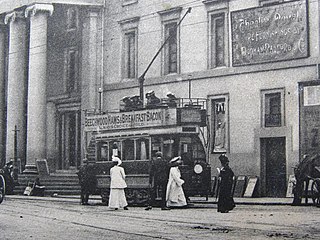
The tramways in Plymouth were originally constructed as four independent networks operated by three different companies to serve the adjacent towns of Plymouth, Stonehouse and Devonport in Devon, England. The merger of the 'Three Towns' into the new borough of Plymouth in 1914 was the catalyst for the three companies to join up under the auspices of the new Plymouth Corporation. The network was closed in 1945, partly as a result of bomb damage during World War II.
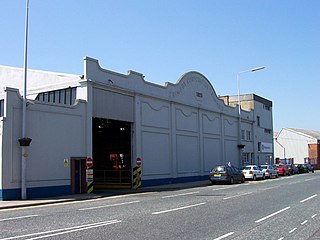
The Great Grimsby Street Tramways Company was a tramway serving Grimsby and Cleethorpes in Lincolnshire, England. It was a subsidiary of The Provincial Tramways Company. They opened a horse tramway in 1881, running from the Wheatsheaf Inn in Bargate to the border with Cleethorpes, with a branch along Freeman Street, and extended the line into Cleethorpes in 1887. It followed the trend of many British systems, and was converted to an electric tramway in December 1901. Small extensions were made to the system at both ends, but the basic plan of the system remained the same throughout its life.
References
- ↑ The Golden Age of Tramways. Published by Taylor and Francis.
- ↑ Gloucester Journal, 24 May 1879
- ↑ UK Retail Price Index inflation figures are based on data from Clark, Gregory (2017). "The Annual RPI and Average Earnings for Britain, 1209 to Present (New Series)". MeasuringWorth . Retrieved 7 May 2024.